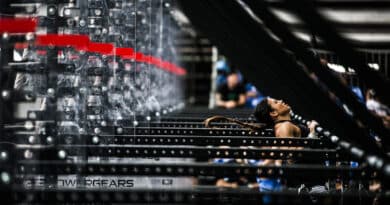Dumbbells Workout for Chest – Build Muscle and A Stronger Upper Body
This Dumbbells workout for chest is designed to help you build muscle, strength and mass. There are several alternate versions of the workout catered towards different specific goals.
If you are aiming to build strength then add the strength version into your training. If muscle gain is your main priority then choose the hypertrophy version.
The Benefits of Strengthening your Chest
A stronger, more muscular chest will improve functional upper body strength, help to balance posture and is highly useful for developing pressing strength. Reapplied to sports, a strong chest is beneficial for everything from Rugby and Stone Lifting to Kayaking and Climbing.
The following workout contains only dumbbells. This creates several advantages.
- Allows for a greater range of motion
- Places less stress on your joints
- Gives you balanced development and strength
- Works the pecs harder resulting in more growth and development
- Uncovers weaknesses in your mobility and strength
The barbell bench press, performed correctly, is a full body movement that incorporates an extensive amount of leg drive. By removing this exercise from the following chest workout (and variations), it shifts the focus towards eliminating imbalances in your strength, forcing a larger range of motion and concentrating on hypertrophy and isolated strength. Dumbbells are also much safer if you must train without a partner to spot you.
Dumbbells Workout for Chest – Hypertrophy
These workouts all start with the heavier compound exercises before moving onto the isolation movements. This works because although isolation exercises are useful, they can’t be as easily overloaded safely with heavier weights. Compound movements can, so performing them first means your body will already be pre-fatigued by the time you move onto exercises such as the flys and pullovers.
With Hypertrophy, choose a weight that is 60 – 70% of your one rep max. The last few reps in each set should be exceptionally difficult.
Hypertrophy Version 1
- Flat dumbbell bench press 4 x 10
- Incline dumbbell bench press 4 x 10
- Flat bench dumbbell flys 4 x 12
- Dumbbell pullovers 4 x 12
- Cable crossovers (drive downwards with handles fixed at top) 4 x 12
Hypertrophy Version 2
- Flat dumbbell bench press 4 x 10
- Decline dumbbell bench press 4 x 10
- Flat bench dumbbell flys 4 x 12
- Dips 4 x 10
- Cable crossovers (drive upwards with handles fixed at bottom) 4 x 12
Dumbbells Workout for Chest – Strength
Strength Version 1
- Flat dumbbell bench press 5 x 5
- Incline dumbbell bench press 3 x 8
- Weighted dips 3 x 8
- Incline bench dumbbell flys 4 x 12
- Press Ups to failure 4 sets
Strength Version 2
- Flat dumbbell bench press 5 x 5
- Decline dumbbell bench press 3 x 8
- Weighted dips 3 x 8
- Flat bench dumbbell flys 4 x 12
- Press Ups to failure 4 sets
Intensity (Loading)
Mike Israetal is the chief sport scientist at Renaissance Periodization. He is also a former Professor of Exercise and Sports Science and an accomplished lifter in his own right. Here are his thoughts when it comes to weights and rep schemes for achieving hypertrophy of the chest.
“Individuals report quite a range of successful loading schemes for the chest, with some getting great use out of super light and metabolite rep ranges and others going up to heavy sets of 5-8 reps per set. Though you should train your chest through a variety of rep ranges in general, what I’ve seen work best is training in the 8-12 rep range.”
He goes on to stress the importance of finding the right weight and progression in order to avoid injury.
“Much heavier and the kinds of volumes needed to really stimulate growth are made unlikely by the joint stress and injury risk of such loads, and much lighter weights seem to give cool pumps for a session or two but in my experience don’t produce growth nearly as reliably as the middle of the road.” Mike Israetal
Training Different Parts of the Chest
There are three classes of exercise that constitute direct chest training. Horizontal pressing moves that train the whole chest, incline pressing moves that train mostly the clavicular (upper chest) fibres and isolation moves that train the chest without involving the triceps.
Horizontal Push:
| Medium Grip Bench Press |
| Wide Grip Bench Press |
| Flat Dumbbell Bench Press |
| Close Grip Bench Press |
| Flat Machine Bench Press |
| Pushup |
| Close Grip Pushup |
Incline Push:
| Incline Medium Grip Bench Press |
| Incline Wide Grip Bench Press |
| Low Incline Dumbbell Press |
| Incline Dumbbell Press |
| Incline Close Grip Bench Press |
| Incline Machine Bench Press |
Chest Isolation:
| Flat Dumbbell Flye |
| Incline Dumbbell Flye |
| Cable Flye |
| High Cable Flye |
| Machine Chest Flye |
| Cable Incline Flye |
| Pec Dec Flye |
Range of Motion
The chest is designed to be stretched under load, and it gets most of its damage and much of its growth stimulus from such motions. So if you’re training your chest and not taking presses as low as they can go (to the chest for barbells and to deeper than the chest by going outside of your shoulders for dumbbells), you’re missing out on chest growth. In fact, by lifting heavier weights than needed when avoiding full ROM, you tax the shoulder and elbow joints MORE and get hurt more often.
Isolation Sandwich Dumbbells Chest Workout
A cool way to design your chest workouts is to use the “isolation sandwich.” We know that isolation moves work great, but they can’t overload with high forces safely quite like compounds. This fact alone would lead us to place isolations only after compound presses. But on the other hand, pre-exhausting the chest with isolations lets the other pushing muscles really make chest the limiting factor and fry it to the bone. So what’s the best way to go? Isolation before or after compounds? Both!
Start with a heavy compound movement for a couple of sets (usually barbells). Then move onto a chest isolation movement once you’ve done your heavy barbell work. After that, use machines or dumbbells to train the pre-exhausted chest and get those benefits as well! Here’s a sample split:
- Barbell Bench Press 4 sets of 8 reps
- Dumbbell Flyes 4 sets of 10 reps
- Dumbbell Incline Press 3 sets of 12 reps
Form
A great mental cue that worked for me was feeling the weight of the dumbbell pushing you back into the bench.
Concentrate on this, the solidity of your retracted shoulders bracing the weight of the weight. Once you’re more aware of the foundation your back makes, suddenly you feel the importance of maintaining that, and extending arms only as far as possible without compromising your back.
Let the barbell push you into the bench. Push the bar away from you, as opposed to trying to lift it high.
Try these Box Step Ups and Lunge Workouts to build stronger legs, and this selection of Shoulder to Overhead Workouts to maximise explosive power for your upper body.





Comments are closed.